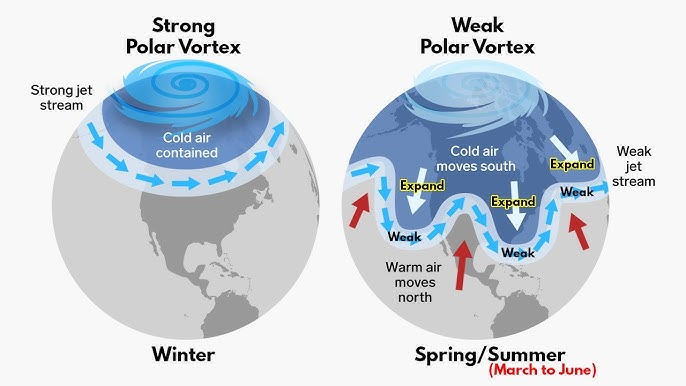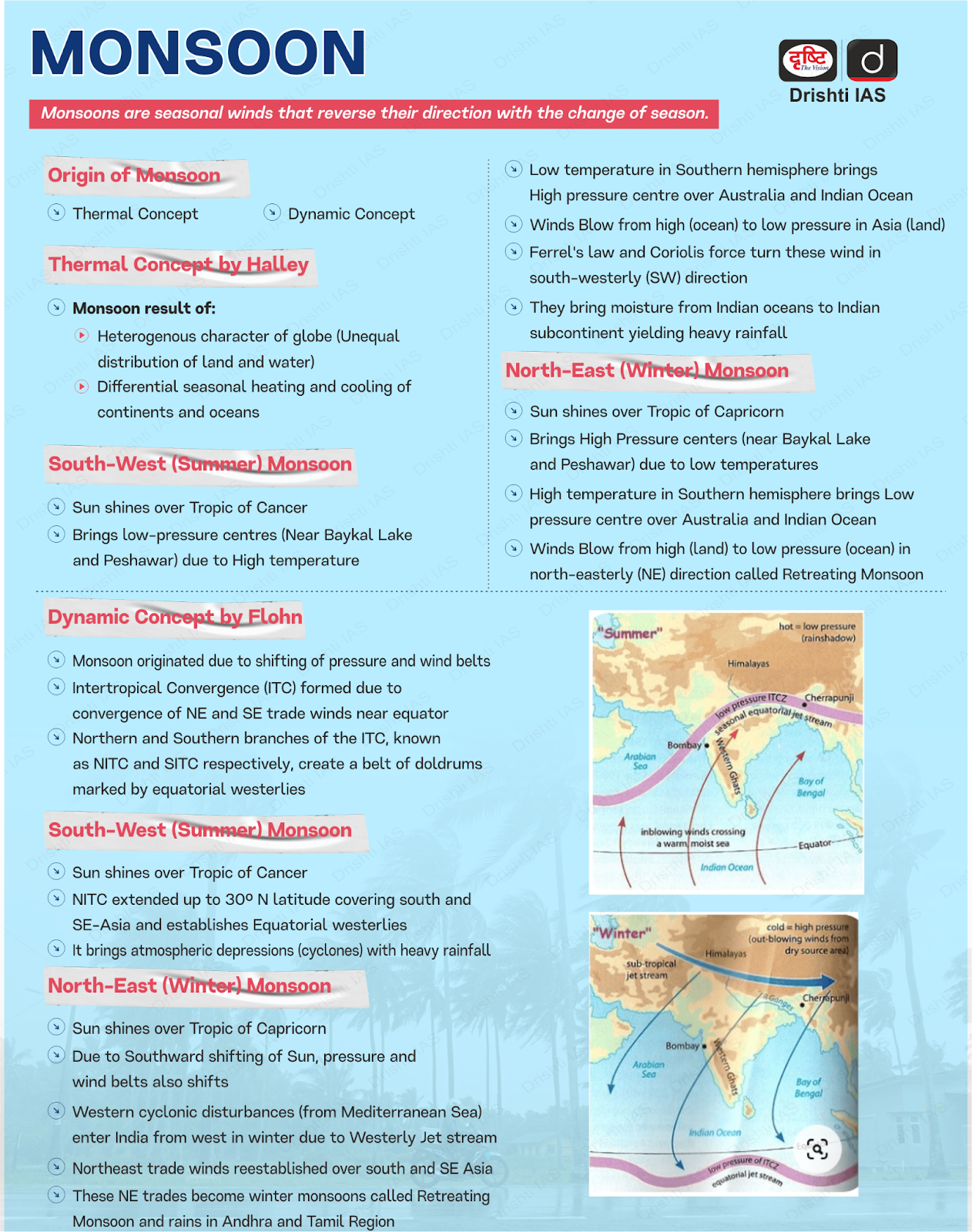Geography
Arctic Sea Ice Impact on Indian Monsoon
- 17 Sep 2024
- 10 min read
For Prelims: India's monsoon pattern, Western disturbances, Arctic Sea ice melting, El Niño and La Niña
For Mains: Significance of Monsoon for India, Impact of Arctic Sea Ice on Indian Monsoon Implications of Changing Monsoon Patterns for India.
Recently research revealed that the decline in Arctic sea ice levels, driven by climate change is influencing the Indian summer monsoon rainfall (ISMR) leading to increased variability and unpredictability.
- It involved researchers from India's National Centre for Polar and Ocean Research (NCPOR), under the Ministry of Earth Sciences, and South Korea's Korea Polar Research Institute.
- Another study attributes the significant rain surplus in northwestern India this monsoon season to long-term trends driven by the climate crisis
How Arctic Sea Ice Influences the Indian Monsoon?
- Central Arctic Sea Ice Decline: Less Arctic Sea (sea ice cover of the Arctic Ocean and its vicinity) leads to reduced rainfall in western and peninsular India, but increased rainfall in central and northern India.
- This is due to increased heat transfer from the ocean to the atmosphere, strengthening Rossby waves, which alter global weather patterns.
- Enhanced Rossby waves cause high pressure over northwest India and low pressure over the Mediterranean, shifting the subtropical easterly jet northward, resulting in more rain over western and peninsular India.
- Low Sea Ice in the Barents-Kara Sea Region: Low sea ice in the Barents-Kara Sea leads to higher pressure over southwest China and a positive Arctic Oscillation, which affects global weather patterns.
- Reduced sea ice causes heat to rise, creating calm, clear skies over northwest Europe.
- This disruption impacts upper atmospheric conditions in subtropical Asia and India, resulting in high rainfall over northeastern India, while central and northwest regions experience less rain.
- Climate Change’s Role: The warming Arabian Sea and moisture from surrounding water bodies further destabilise weather patterns, exacerbating the variability in monsoon rainfall.
What are the Findings of the Study Related to Surplus Rain in North-Western (NW) India?
- Increased Moisture from the Arabian Sea: NW India is experiencing a wetter monsoon season due to increased moisture inflow from the Arabian Sea. This trend is expected to continue, particularly under high emissions scenarios.
- Changes in Wind Patterns: The region’s increased rainfall is linked to altered wind patterns. Faster winds over the Arabian Sea and slower winds over northern India trap moisture in northwestern India.
- Enhanced evaporation from the Arabian Sea, driven by these winds, also contributes to the region's increased precipitation.
- Shifts in Pressure Gradients: Changes in wind patterns are attributed to shifts in pressure gradients.
- Increased pressure around the Mascarene Islands (Indian Ocean) and decreased pressure in the equatorial Indian Ocean have strengthened the monsoon winds that bring rain to northwestern India.
- Amplified Winds from East-West Pressure Gradient: An increased east-west pressure gradient, influenced by higher pressure over the eastern Pacific, further amplifies these winds. This could potentially lead to even wetter monsoons in the future.
Rossby Waves
- These are large-scale atmospheric waves, also called planetary waves, that occur primarily in the mid-latitudes of the Earth's atmosphere.
- They form in jet streams with high-altitude air currents flowing from west to east and have a meandering pattern that influences weather across the Northern and Southern Hemispheres.
- These waves are most prominent where there is a large temperature contrast between the equator and the poles.
- They play a key role in shaping global weather patterns, affecting temperature extremes and precipitation levels.
- Rossby waves help balance global heat distribution, preventing polar regions from becoming too cold and equatorial regions from overheating.
What is the Indian Summer Monsoon Rainfall (ISMR)?
- About: The Indian Summer Monsoon Rainfall (ISMR) is a major climatic phenomenon that occurs when moist air from the Indian Ocean moves towards the Indian subcontinent.
- It occurs over the Indian subcontinent from July to September with most of the rains recorded in July and August.
- Factors Influencing ISMR: ISMR is influenced by the surface temperatures of the Indian, Atlantic, and Pacific Oceans, as well as the circum-global teleconnection (CGT), a large-scale atmospheric wave flowing at the mid-latitudes.
- Formation:
- Sunlight warms the Central Asian and Indian landmass more rapidly than the surrounding ocean, creating a low-pressure band known as the Intertropical Convergence Zone (ITCZ).
- Trade winds blowing from the southeast are deflected toward the Indian landmass due to the Coriolis force.
- As these winds cross the equator and move over the Arabian Sea, they gather moisture and release it as rainfall over India
- The southwest monsoon splits into two arms. One bringing rain to the west coast (Arabian Sea arm) and the other to India’s eastern and northeastern parts (Bay of Bengal arm).
- These arms converge over Punjab and Himachal Pradesh.
- India Winter Monsoon Rainfall: The northeast monsoons is the reversal phase of monsoon during the winters (due to the high-pressure cells that are formed over the Siberian and Tibetan plateaus).
- It occurs during October to December.
What is the Significance of the Monsoon for India?
- Agricultural Backbone: The monsoon is crucial for Indian agriculture, impacting food security and rural livelihoods. With 61% of farmers reliant on rainfall, a well-distributed monsoon supports 55% of India’s rain-fed crops and influences agricultural productivity and the economy.
- Water Resource Management: India receives 70-90% of its annual rainfall during the monsoon season (June to September), essential for replenishing rivers, lakes, and groundwater.
- This period is vital for irrigation, drinking water, and hydroelectric power.
- Economic Ripple Effects: A good monsoon boosts rural incomes and consumer demand, while a poor monsoon can cause food price inflation and impact the overall economy, influencing monetary policy and government spending.
- Ecological Balance: The monsoon supports India’s diverse ecosystems, affecting biodiversity, wildlife migration, and habitat health. Changes in monsoon patterns can disrupt flora and fauna.
- Climate Regulation: The Indian monsoon plays a key role in global climate regulation, influencing atmospheric patterns and interacting with phenomena like El Niño and La Niña.
Arctic Ocean
- It is the smallest of the world's oceans, centering approximately on the North Pole.
- It is bordered by Canada, Greenland, Iceland, Norway, Sweden, Finland, Russia, and the United States.
- Key Seas: Includes the Barents, Kara, Laptev, East Siberian, and Beaufort Seas.
- Ice Coverage: Predominantly covered by sea ice, with patterns of seasonal melting and freezing.
- Climate Change: Rapid warming has diminished ice cover, leading to new shipping routes (e.g., Northern Sea Route) and increased access to resources.
- Resources: Home to an estimated 13% of the world’s undiscovered oil and 30% of its natural gas reserves.
Drishti Mains Question:
Discuss the impact of shifting monsoon patterns on agricultural productivity in India. How do these changes affect food security and rural livelihoods?
UPSC Civil Services Examination, Previous Year Question (PYQ)
Prelims:
Q. With reference to ‘Indian Ocean Dipole (IOD)’ sometimes mentioned in the news while forecasting Indian monsoon, which of the following statements is/are correct? (2017)
- The IOD phenomenon is characterized by a difference in sea surface temperature between tropical Western Indian Ocean and tropical Eastern Pacific Ocean.
- An IOD phenomenon can influence an El Nino’s impact on the monsoon.
Select the correct answer using the code given below:
(a) 1 only
(b) 2 only
(c) Both 1 and 2
(d) Neither 1 nor 2
Ans: (b)
Mains:
Q. How far do you agree that the behavior of the Indian monsoon has been changing due to humanizing landscape? Discuss. (2015)










